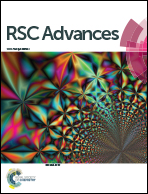Mechanistic insight into the non-hydrolytic sol–gel process of tellurite glass films to attain a high transmission†
Abstract
The development of amorphous films with a wide transmission window and high refractive index is of growing significance due to the strong demand of integrating functional nanoparticles for the next-generation hybrid optoelectronic films. High-index TeO2-based glass films made via the sol–gel process are particularly suitable as their low temperature preparation process promises high compatibility with a large variety of nanoparticles and substrates that suffer from low thermal stability. However, due to the lack of in-depth understanding of the mechanisms of the formation of undesired metallic-Te (highly absorbing species) in the films, the preparation of high-transmission TeO2-based sol–gel films has been severely hampered. Here, by gaining insight into the mechanistic chemistry of metallic-Te formation at different stages during the non-hydrolytic sol–gel process, we identify the chemical route to prevent the generation of metallic-Te in a TeO2-based film. The as-prepared TeO2-based film exhibits a high transmission that is close to the theoretical limit. This opens up a new avenue for advancing the performance of hybrid optoelectronic films via incorporating a large variety of unique nanoparticles.



 Please wait while we load your content...
Please wait while we load your content...